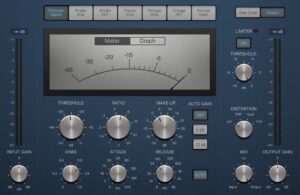Final Verdict: The latest version of Apple Logic Pro X is an absolute must-have for producers and audio engineers. Its intuitive user interface, custo
Final Verdict: The latest version of Apple Logic Pro X is an absolute must-have for producers and audio engineers. Its intuitive user interface, customizable light/dark mode, and inclusion of Dolby Atmos & Spatial Audio make it a standout in the DAW market. Plus, with the ability to easily strip down or max out features according to your needs, this free update is an essential tool for any producer’s sound library.
| Expansive music production capability | Incompatible headphones can prevent users from utilizing Spatial Audio tempo events are not able to be linked with SMPTE |
| Compatibility with other professional applications that is constantly increasing | Meters and faders could be larger on the mixer |
| A one-time purchase fee with free updates | Fast Clip-Gain style audio editing is unavailable |
| Two modes – simplified and full feature | Logic Pro may intimidate newcomers initially |
| Improved support for the Apple ecosystem tool | Mac operating systems only |
| regularly released loops, instruments, and audio patches |
Apple’s Logic Pro and Logic Pro X are two of the most advanced audio production software available today. For podcasting, they may be overkill – but that also makes them future-proof and ideal for those who want to stay ahead of the curve. With their re-imagined design, Apple has revolutionized media creation with iMovie and Final Cut Pro X. This move from professional to more mainstream–friendly tools has not been without controversy. However, it does mean a great deal for anyone interested in using Logic Pro X for podcasting or audio production.
What Is Logic Pro X?
Having been acquired by Apple in 2002, Logic Pro X is the brand’s most popular audio production software and highly regarded among audio editors.
Logic Pro X is a podcast editing software created for Apple iOS and Mac users. Its main use is focused on music production, but it can be used to edit podcasts too. The software includes features such as fade-in/fade-out effects and other traditional editing functions. And this will ensure the final output has an impressive professional sound quality.
You’ll be pleased to discover that Pro X has some of the same DNA as GarageBand, so if you know how to use GarageBand, you can quickly get started with Pro X. In addition, it now employs multi-touch gestures to allow for customizing the tone of individual tracks by using Visual EQ. Moreover, it has a plugin manager that organizes your menu and keeps all necessary plugins.
Main Features of The Software
Live Loops
In the Live Loops view, located above the track headers, you can explore new ideas by dragging and dropping loops, samples, and audio recordings into a grid of nine squares. Then, you can click on these cells to trigger them in different combinations. Adding audio MIDI or pattern regions to this view is as easy as dragging and dropping them. To make multiple loops play together simultaneously, add them to the same column and click the column number at the bottom.

Remix FX
The Remix FX plug-in enables you to create transitions, stutter edits, gates, virtual record scratches, and other production techniques. The plugin features eye-catching animations that respond to your movements, whether opening and closing filters via the pads or manipulating them by tilting an iPad/iPhone up and down. And this powerful tool has been tested without any latency issues and can be applied across mixed buses as well as individual tracks.
Step Sequencer
This edit window offers an easy and efficient way to create melodies, bass lines, and rhythms. It features a stylish interface inspired by FL Studio with 150 included rhythm and melody patterns. Plus, you can use it for creating beats, including drum parts, melodic elements, and controller data automation alongside various variations.
Sampler
Apple has put an end to the EXS24 software instrument sampler and replaced it with a newer version called Sampler. This new sampler boasts a modern design, allowing users to customize its interface and access more options than before.
Logic now has a native plug-in that provides the core workstation-style sample set. Sampler enables users to create and edit samples in the waveform editor, use filters on them, map samples across different keys and dynamics levels, drag and drop files into it, and preserve sample lengths regardless of the pitch with Flex Time.
Compressor
Logic’s renowned compressor has received an enhanced visual overhaul, with fresh faces for each of its main modes. Additionally, it now offers a dbx 160-based Classic VCA emulation mode that is even more adjustable than before. The interface can also be adjusted to scale perfectly on 5K Retina displays if you own one of the latest iMac models.
 Flex Time & Flex Pitch
Flex Time & Flex Pitch
Flex Pitch and Flex Time enable vocal tuning and correcting errors in recorded audio tracks to be done quickly.
Instead of requiring an extra app to generate audio fade files for each project, fades are calculated and executed in real-time. Besides this is more efficient and makes projects load faster, plus it can work with the helpful Flex Pitch feature at no additional cost.
Limitations Of Logic Pro X
| Only Available on iOS | If you’re a PC user, Adobe Audition is your main choice for audio editing software. Other alternatives are available, but none can compare to the power of Logic Pro X, which Apple has made exclusive to its iOS devices. For podcasting purposes, however, plenty of other affordable options can provide the same level of quality as Logic Pro X. Thus, making it unnecessary unless you’re doing more advanced productions. |
| Steep Learning Curve | Logic Pro X can be a difficult platform for newcomers, as it requires familiarity with Pro Tools and iOS. The transition from other production-level software to Logic Pro X is often abrupt, leading to a steep learning curve for many. |
| Designed for Music Editing | Logic Pro X is a music editing software, so it can be useful for podcast editing. Though some of its features may not be as easily accessible. It’s designed mainly to create and edit music rather than podcasts, so the tools may require a few more steps when podcasting. |
How Much Is Logic Pro X
Logic Pro can be purchased from the Apple App Store and is available for an initial outlay of $199.99 / £174.99, after a 90-day free trial period has expired. This one-time cost provides users access to all future updates without additional fees or charges. Simply visit the Apple App Store when each major or minor update is released to download it for free.
To start with Logic Pro, you will need a Mac computer running macOS 11.0 or higher and 6GB of free space for the main software. For full functionality, including all additional synths, instruments, loops, and effects that come with it, you should have 72GB of storage available. No extra hardware or software protection is necessary once logged into your Apple Store account. Simply download the program and run it without issue.






COMMENTS